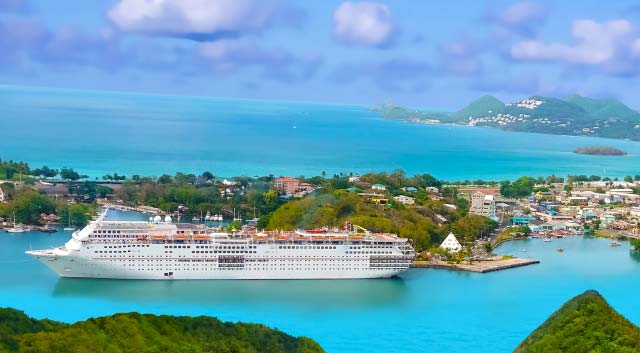Smooth Sailing: What First-Time Cruisers Need to Know

Cruising can be an incredibly rewarding vacation experience, offering a chance to explore multiple destinations while enjoying the amenities and entertainment of a floating resort. However, for those who have never set sail before, the prospect of booking and preparing for a cruise can seem daunting.
With so many options available -from ship size and itinerary to activity offerings and price points -it's easy to feel overwhelmed.
Fear not, first-time cruisers! This guide is here to help you navigate the waters of planning and setting off on your inaugural voyage. From selecting the right cruise line and itinerary to packing smart and staying safe, we'll cover all the essential tips and tricks to ensure a smooth and memorable journey. And, even if it's not your first cruise, you're bound to get some great ideas along the way.
So, get ready to embark on an adventure and create lasting memories as you discover the joys of cruising for the very first time.
Choosing the right cruise
Choosing your first cruise can be daunting. You go to a cruise line’s website or the website of an online travel provider and there are so many cruises. All the ships look great, the ports-of-call are intoxicating, and the prices are all over the place.
How do you narrow it down? Start by looking in the mirror.
Who are you? What would you like to do on a ship: eat, work out, relax, dance, swim, sunbathe?
And what do you want to do off the ship – go sailing, ride horses, shop, explore … or maybe not get off the ship at all?
And are there places you’ve always dreamed of visiting where a cruise sails – Alaska or Tahiti or Antarctica or the Greek islands?
Once you understand who you are in relation to a cruise you can pick a better cruise for you. For instance, if you’re interested in history a European river cruise is a great idea. They tend to give you a lot of time to visit the historic European cities where they stop, and many excursions are geared toward history buffs.
Explorer types often find an Arctic, Antarctic, or Galapagos cruise rewarding. And homebodies often gravitate toward Alaska or St. Lawrence Seaway cruises.
Finally, there are theme cruises out there that cater to everything from mystery lovers to metalheads. If a themed or specialty cruise interests you, make sure the theme and activities are things you love.
Start here: 7 Great Cruise Destinations Around the World
Knowing where you’re going can help you and your travel professional narrow down cruise lines – especially after you have that talk about the elephant in the room: How much you’re willing to pay.

Calculating the cost
An online search will turn up cruises that appear to cost a few hundred dollars and cruises that cost tens of thousands of dollars, and they go to the same places. What’s the difference?
Length: When calculating cruise cost, divide the total cost by the number of days at sea. Your per-day cost is often a better number for comparison than the overall cost.
Add-Ons: Here’s where the dollars can really pile up. Most cruise lines have upcharges for:
- Alcohol and other drinks
- Premium dining
- Wi-Fi
- Services like spas and hair salons
This is in addition to the cost of excursions, medical services, tipping, casinos, and more.
Cruise lines make a lot of money by selling these services, so they price and market them aggressively.
However, just like resorts, there are some cruise lines that are more all-inclusive. You pay a high per-day base rate, and these cruises have a higher published cost, but they include more.
Amenities: If you want to be pampered from dawn to dusk, there are cruises that will do that, but you’ll have to pay for the privileges.
Cruise time: There’s a shoulder season for cruises, just as there is for practically every other form of travel. You’ll pay less, but the weather may not be as nice. It may be cooler, or in the case of Caribbean cruises, it may be closer to hurricane season.
Pay attention to the long-range forecasts from the National Oceanic and Atmospheric Administration before you book a Caribbean cruise.
Booking time: Some cruise lines offer a significant discount if you put a deposit on a cruise far in advance of departure. Others offer deep discounts if you book at the last minute.
Who you cruise with: If you cruise solo you’ll usually pay a “single-supplement” fee. On the flip side, the more people you cruise and share a cabin with, the lower the cost per person generally becomes.
Small vs. large: Because cruise ships have a lot of fixed costs, often you’ll find the smaller the ship, the higher the cost per person.
Getting there and getting back: Some cruises include airfare and even lodging to and from your cruise. Most don’t. Many people find taking a day on either side of their cruise is helpful. Calculate that into your cost.
Read before you buy: What Travelers Need to Know About Cruise Cancellation Risks

Time on the boat
For all the efforts a cruise ship makes to keep you active and entertained while onboard, the fact remains that you are on a ship and cannot get off until the ship docks.
Some ships do all their sailing at night and dock for the day, helping alleviate some of that trapped feeling. These cruises are a good option if you’re afraid you might feel confined by too much daytime sailing time.
If, on the other hand, you can’t get enough of the passing ocean, consider a cruise with a high degree of sea travel – maybe even an Atlantic cruise from New York to England, in the best tradition of the great luxury liners.
Once you’ve chosen your cruise
Packing
Choosing a cruise is usually the hardest part for most first-timers. The second-hardest part is deciding what to pack.
Fortunately we’ve created a comprehensive cruise-packing checklist with packing hacks for you to download.
That article really covers it all, but to hit the highlights:
- Pack layers, no matter what type of cruise you’re taking. That can mean a sweatshirt or cotton sweater and rain jacket for warm-weather cruises or base layers and down for cold-weather cruises. But however you layer, think modular for flexibility and comfort.
- Use packing cubes and roll, don’t fold.
- One or two nice outfits are all you’ll need, especially if you can mix-and-match.
- Pack your carryon with two days’ worth of clothes and toiletries, just in case.
- Don’t forget chargers and power adapters.
Beyond that, remember your passport. Depending on your ports-of-call you may be able to get away with just carrying a passport card, but either way, you need to make sure your travel documents are up-to-date.

Departure day
Departure day may seem like a bit of a mad scramble, but if you’ve read the emails and other communications from the cruise line (tip: follow them on social media) it should go like clockwork.
These tips will help:
- If you’re flying to your port-of-call, plan to fly in at least one day before your cruise departs. This gives you buffer time in case flight delays or other travel mishaps occur, you might still have time to make your cruise!
- Pay attention to when you can sign up for a boarding time. It’s like checking in on a plane; the nearer to the open time you are, the sooner you can board the ship.
- Keep all your paperwork in one place and have it handy. If your cruise line sent you digital QR codes, don’t forget your phone and make sure it’s charged.
- Once you’re through security you have the run of the ship – though your cabin may not be ready. Grab something to eat and orient yourself to where everything is.
- There will likely be a lot of people congregated in the atrium, and the buffet lines will be long. It won’t always be like that; scout out alternatives when you first board.
- Pay attention during the safety briefings. There will probably be a test later, in the form of a full-on safety drill.

Health and safety – and travel protection
Finally, some health and safety tips:
- Cruise ships really are floating petri dishes, so make sure your immunizations are current.
- Practice good sanitation habits. Wash your hands frequently.
- While on excursions, don’t drink tap water or drinks with ice in them. When buying street food, look for dishes that are hot and freshly prepared.
- Be safe while taking part in on-water excursions. Wear life jackets, avoid rip currents, and watch out for dangerous marine life.
- Seasickness is real. Pack Dramamine or seasickness-preventing pressure bands.
The last safety tip might be the most important: Buy travel protection. Cruises are one of the most-insured trip types for some important reasons:
- They’re expensive
- They have a lot of prepaid costs that can be hard to get back if you cancel
- They’re prone to cancellation due to bad weather and other catastrophic events
- Medical emergencies, when they happen, tend to be costly and complex
For those reasons and more many travelers choose travel insurance with assistance services from Generali Global Assistance to help protect their cruise.
Plans like our Premium Plan are designed to help protect all the prepaid and nonrefundabe costs that go into a cruise - and your health, should you have a medical emergency on your cruise.
Getting covered is easy. It starts with getting a quick quote.
And that's it! Cruises really are one of the most carefree travel types out there. With a little planning, some smart packing, and travel protection from Generali Global Assistance, you're all set for the vacation of a lifetime.
B00800240


